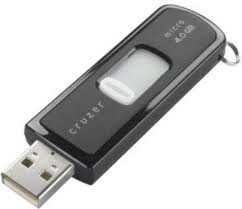Abstract

A typical flash drive
A small, portable memory card that plugs into a computer’s USB port and essentially functions as a portable hard drive. They are also called thumb drives, jump drives, pen drives, key drives, tokens, or simply USB drives. Their main advantages are light weight, small size, simple USB access, reasonable storage (many GB presently) at lost cost, lack of moving parts, and non-volatile storage (i.e. no power is needed to keep the information intact). Some disadvantages include relatively slow access speeds especially when writing information and also their limited lifetime in terms of writing and erasing (i.e. only a finite number of writes and erases are supported without damage to the flash drive).
The physical storage principle is to create patterns of electrical charges in the specialized floating-gate transistors inside the flash drives; the presence or absence of electric charge modifies the conductivity of the transistors which is the basis for reading out the information.